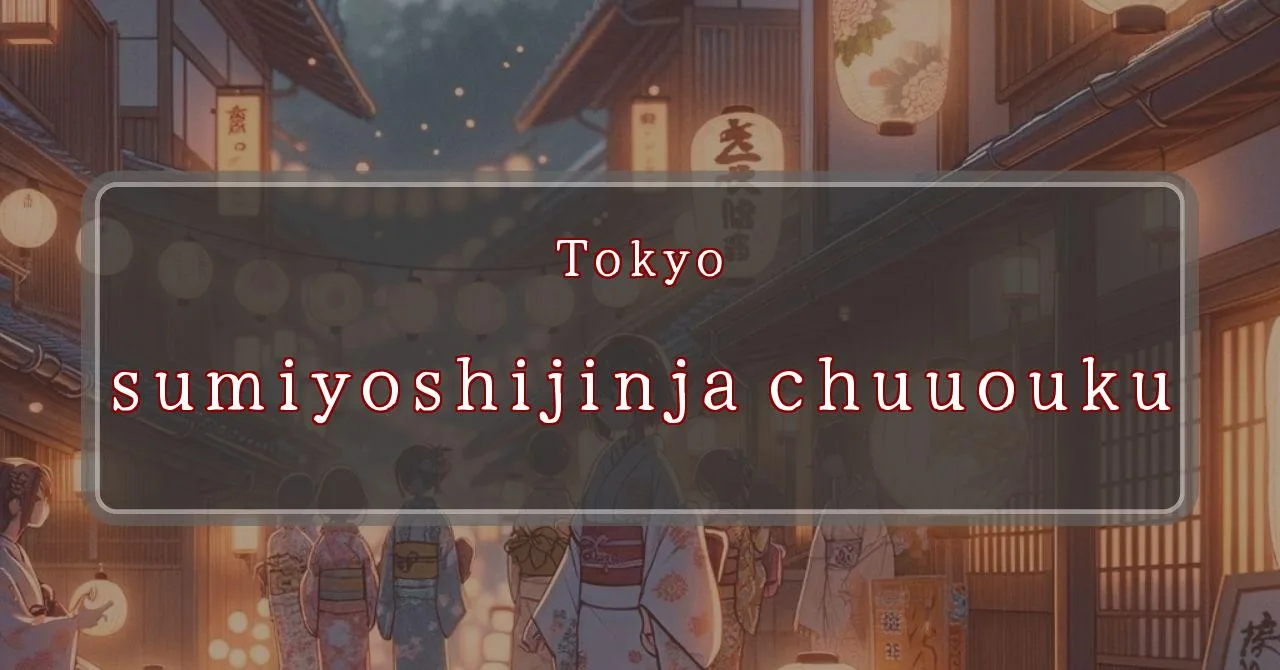Enchanting shrine festival with 600-year history
Basic Information
Sumitomo Shrine is a Shinto shrine located in Tsukuda, Chuo Ward, Tokyo, Japan. It is dedicated to the gods Sokotsutsu-no-o-no-mikoto, Nakatsutsu-no-o-no-mikoto, and Uwatsutsu-no-o-no-mikoto, collectively known as the Sumiyoshi Sanjin.
- Address: 1-1-14 Tsukuda, Chuo-ku, Tokyo 104-0051
- Phone Number: 03-3531-3500
- Access: 5-minute walk from Exit 6 of Tsukishima Station on the Tokyo Metro Yurakucho Line and Toei Oedo Line.
- Festival Days: August 4th (Sat) to August 7th (Tue), 2024
Main Events and Attractions of the Festival
The Sumiyoshi Shrine Festival, also known as the Tsukuda Festival, is a vibrant and lively event that attracts many visitors each year. The festival is held over four days, from August 4th to August 7th, and features a variety of events and attractions, including:
獅子頭宮出し (Shishigashira Miyadashi)
The highlight of the festival is the Shishigashira Miyadashi, or lion head parade. On the first day of the festival, seven pairs of lion heads are carried through the streets of Tsukuda by young men from the Tsukuda Jinguji Association. The lion heads are believed to ward off evil spirits and bring good luck, and the parade is a lively and colorful spectacle.
神輿渡御 (Mikoshi Togyo)
On the second day of the festival, the mikoshi, or portable shrine, is carried through the streets of Tsukuda. The mikoshi is believed to be inhabited by the gods of the shrine, and the procession is a solemn and respectful event. Visitors can line the streets to watch the procession and pay their respects to the gods.
船渡御 (Funatogyo)
On the third day of the festival, the mikoshi is taken on a boat procession around the Sumida River. This is a unique and beautiful event, and visitors can enjoy watching the mikoshi from the banks of the river or from boats on the water.
八角神輿巡幸 (Hakkaku Mikoshi Junkō)
On the final day of the festival, the hakkaku mikoshi, or octagonal portable shrine, is carried through the streets of Tsukuda. The hakkaku mikoshi is a large and impressive shrine, and the procession is a lively and festive event. Visitors can join in the procession or watch from the sidelines.
- Content: Carrying of the hakkaku mikoshi through the streets of Tsukuda
- Features: Large and impressive shrine, lively and festive procession
Blessings and Deities
Sumitomo Shrine is dedicated to the three gods of Sumiyoshi: Sokotsutsu-no-o-no-mikoto, Nakatsutsu-no-o-no-mikoto, and Uwatsutsu-no-o-no-mikoto. These gods are collectively known as the Sumiyoshi Sanjin, and they are revered as the protectors of seafarers and fishermen. In addition, the shrine also enshrines the spirit of Tokugawa Ieyasu, the founder of the Tokugawa shogunate.
- Sumiyoshi Sanjin: Gods of seafarers and fishermen
- Tokugawa Ieyasu: Founder of the Tokugawa shogunate
Origin and History
Sumitomo Shrine was founded in 1646 by order of Tokugawa Ieyasu. The shrine was originally located in the Tsukiji district of Tokyo, but it was moved to its current location in Tsukuda in 1872. The shrine has been a popular place of worship for centuries, and it is especially revered by seafarers and fishermen.
- Founded in 1646 by Tokugawa Ieyasu
- Originally located in the Tsukiji district of Tokyo
- Moved to its current location in Tsukuda in 1872
- Popular place of worship for seafarers and fishermen
Tips and Notes for Visitors
Here are some tips and notes for visitors to the Sumiyoshi Shrine Festival:
- The festival is very popular, so it is important to arrive early to avoid crowds.
- Wear comfortable shoes, as you will be doing a lot of walking.
- Bring a hat and sunscreen, as the festival is held outdoors.
- There are many food and drink stalls at the festival, so you can enjoy a variety of Japanese cuisine.
- The festival is a great opportunity to learn about Japanese culture and traditions.
Parking Information
There is no parking lot at Sumitomo Shrine, so visitors are advised to use public transportation or park in a nearby parking lot.
- No parking lot at Sumitomo Shrine
- Use public transportation or park in a nearby parking lot
Popular Stalls and Food Carts in Recent Years
| Type of Stall | Description |
|---|---|
| Takoyaki | A staple at Japanese festivals. Characterized by a crispy outside and a creamy inside. |
| Jaga Butter | A simple yet popular snack of hot potatoes lavishly topped with melted butter. |
| Baby Castella | Small castella cakes, sweet and fluffy treats enjoyed by children and adults alike. |
| Grilled Ayu with Salt | Fresh ayu fish grilled whole with salt, a savory taste of Japanese summer. |
| Shaapin | A unique gourmet item influenced by foreign cuisine, with a chewy skin wrapping the filling. |
| Okonomiyaki | A Japanese grilled dish where you often choose your own ingredients for a personalized flavor. |
| Cotton Candy | A fluffy, sweet snack that’s extremely popular with children. |
| Chocolate Banana | A banana coated in chocolate, a fun and visually appealing dessert. |
| Kushiyaki | Various types of ingredients skewered and grilled, an easy-to-enjoy snack. |
| Yakisoba | Fried noodles mixed with a special sauce, a fast food favorite in Japan. |



